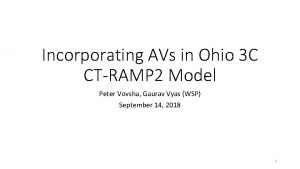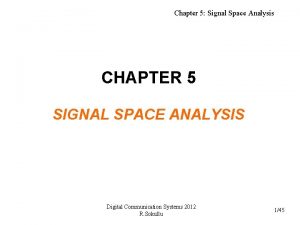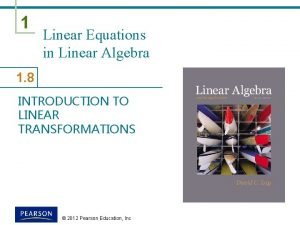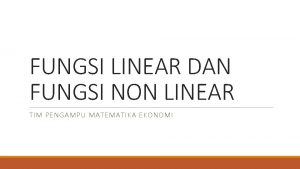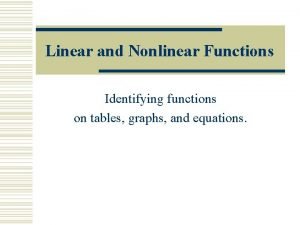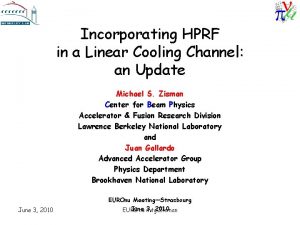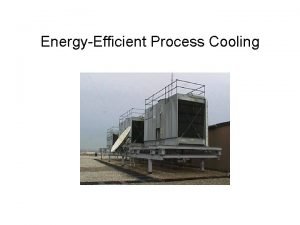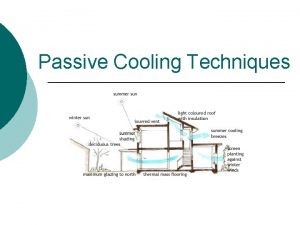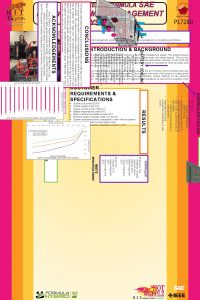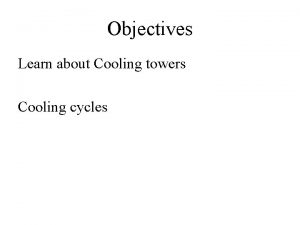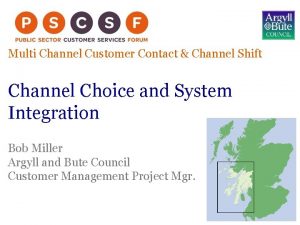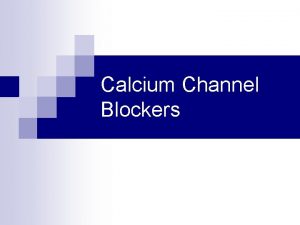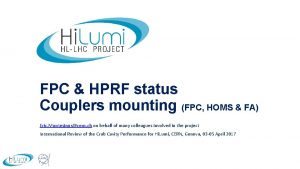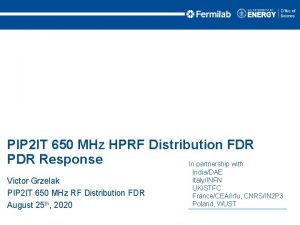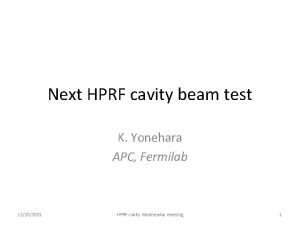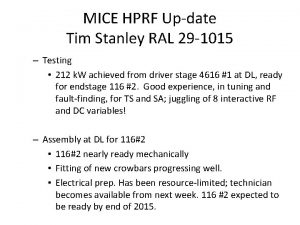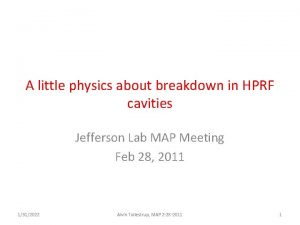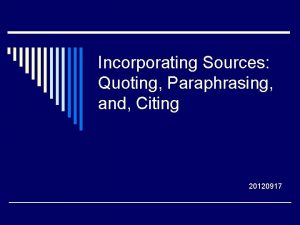Incorporating HPRF in a Linear Cooling Channel an






















- Slides: 22

Incorporating HPRF in a Linear Cooling Channel: an Update Michael S. Zisman Center for Beam Physics Accelerator & Fusion Research Division Lawrence Berkeley National Laboratory and Juan Gallardo Advanced Accelerator Group Physics Department Brookhaven National Laboratory June 3, 2010 EUROnu Meeting—Strasbourg June mtg: Zisman 3, 2010 EUROnu

Outline • Introduction • HPRF issues • Hybrid channel strategy • Initial evaluation • Window thickness optimization • Use of Be isolation windows • Window material comparison • Li. H “optimization” • Pressure comparison • Comments on implementation • Possible implementations • Implementation issues • Hardware R&D • Summary June 3, 2010 EUROnu mtg: Zisman 2

Introduction • We have evidence that vacuum RF cavity gradient performance degrades in a strong magnetic field — alternative approach of HPRF does not o though it has other potential issues • It seems prudent to begin investigating the technical aspects of implementing HPRF in a linear cooling channel — minimizes changes in cooling channel layout and hardware MCTF June 3, 2010 EUROnu mtg: Zisman 3

HPRF Issues • Many differences between HPRF and “standard” linear cooling channel — energy loss distributed rather than limited to discrete absorbers — loss medium gaseous rather than liquid hydrogen or Li. H o likely requires some modularity for safety reasons — must match gradient to energy loss, even if max. gradient can be higher o cannot take full advantage of high maximum gradient MCTF June 3, 2010 EUROnu mtg: Zisman 4

Hybrid Channel Strategy • Primary purpose of HPRF is to avoid degradation from magnetic field — use gas only to deal with this task o requires much lower pressure than to reach material limit • For the Study 2 a case, we need gradient of ~15 MV/m — from HPRF test cavity, expect this to require only ~10 atm at room temperature o or ~2. 5 atm at 77 K — need eventually to confirm with 201 -MHz cavity • At this pressure, GH 2 E is ~¼ of Li. H E — reduce Li. H thickness by 25% to maintain same overall E o not exactly right due to different beta weighting – but, a reasonable starting point for re-optimizing channel performance June 3, 2010 EUROnu mtg: Zisman 5

Initial Evaluation (1) • Looked at performance of proposed “hybrid” channel (Gallardo) — results encouraging, but not yet optimized o not much change in performance between gas-filled hybrid (red line) and vacuum (black line) channels – isolation window does have a substantial effect June 3, 2010 EUROnu mtg: Zisman 6

Initial Evaluation (2) • Took quick look at effect of adding even one more Ti isolation window (Gallardo) — it hurts! — maintenance can be accommodated with gate valves o safety considerations may dictate more subdivisions – need to explore using lower Z window material ¨ hydrogen embrittlement must be evaluated for each choice June 3, 2010 EUROnu mtg: Zisman 7

Window Thickness Optimization • Initial estimates used flat windows (uniform thickness) — engineering guidance (Lau) says that window can be thinner in the middle — implemented in ICOOL (crudely) Isolation window o it helps substantially (as seen by physicist) Isolation window (as seen by engineer) June 3, 2010 EUROnu mtg: Zisman 8

Use of Be Isolation Windows • Since Ti (or stainless steel) cause losses, look at using Be windows — use design concept from previous slide o even 17 windows looks acceptable – is this too good to be true? June 3, 2010 EUROnu mtg: Zisman 9

Window Material Comparison • To make sure we were not fooling ourselves, ran cases with both Be and Ti — the difference is obvious • Will next look at Al and Al. Be. Met windows as time permits — Al is okay in terms of hydrogen embrittlement; not yet sure about other materials June 3, 2010 EUROnu mtg: Zisman 10

Li. H “Optimization” (1) • Looked at 34 atm performance for various Li. H thicknesses — emittance reduction and transmission do not optimize simultaneously o isolation windows play a role — for NF, transmission is the more important quantity to optimize o probably true for MC also in early stages of cooling June 3, 2010 EUROnu mtg: Zisman 11

Li. H “Optimization” (2) • Carried out same exercise for 10 atm scenario — again, emittance and transmission optimize differently June 3, 2010 EUROnu mtg: Zisman 12

Pressure Comparison • Looked at best cases for 34 and 10 atm — about the same o infer that desired performance can be obtained over a broad range of parameters June 3, 2010 EUROnu mtg: Zisman 13

Comments on Implementation • Modular system, with independent gas supplies and isolation windows, seems feasible — if low-Z isolation windows are okay • Materials issues must be carefully considered — hydrogen embrittlement must be evaluated for all structural materials o also Cu, Be, and Li. H; Al and Be-Cu alloys are particularly resistant • Operating at LN temperature reduces P by factor of ~4 — but complicates engineering of channel o insulating vacuum, cooling of RF cavities, differential contraction, . . . — not convinced this is worth the trouble June 3, 2010 EUROnu mtg: Zisman 14

Possible Implementation (A) • Proposed concept with buffer vacuum illustrated here Cavity must be a pressure vessel! Gas only in cavity and beam pipe; permits cryogenic operation if needed June 3, 2010 EUROnu mtg: Zisman 15

Possible Implementation (B) • A more “MICE-like” version is illustrated here Cavity can be a thin-walled vessel Gas fills entire vessel; likely incompatible with cryogenic operation June 3, 2010 EUROnu mtg: Zisman 16

Implementation Issues (A) • Pressure-vessel code issues must be dealt with for cavities and beam pipe — walls must be thick enough to withstand pressure • RF window must be pressurized on both sides to 34 atm — Moretti believes this can be done with special epoxy “plug” o used successfully in MTA tests of 805 -MHz HPRF cavity • Vent/fill line design must avoid P on Li. H windows • Cryogenic operation probably possible — need to insulate fill/vent lines outside vacuum area — need to accommodate differential contraction (e. g. , between sections) o usually use bellows for this, but may not be possible with 34 atm of gas • On the plus side, can likely keep hydrogen zone contained within apparatus June 3, 2010 EUROnu mtg: Zisman 17

Implementation Issues (B) • Cavity and tuners could be similar to MICE implementation • Bellows connections between sections may not be permitted • Vent/fill line must avoid P on Li. H windows • Cryogenic operation more difficult — would require a vacuum-insulated outer layer — warming individual sections would be problematical unless bellows are permissible • Outer vessel is a (substantial) pressure vessel • Area outside containment vessel probably a hydrogen zone — special requirements for electrical equipment, lights and switches, hydrogen sensors, . . . — use of benign gas (e. g. , N 2, CO 2) in outer containment area possible o filling and emptying become trickier June 3, 2010 EUROnu mtg: Zisman 18

Hardware R&D Program (1) • Cooling channel concept similar to that tested in MICE — if simulation tools are vetted, no need for muon beam experiment • HPRF tests already planned will answer primary question, whether the gas will stand up to the intense ionizing radiation without shorting out the cavity — this is key remaining issue o if not, must check whether additives (e. g. , SF 6, CO 2) will solve problem • Testing a 201 MHz cavity in implementation B should be done to pin down required pressure to get 16 MV/m — if no frequency effect, may need only ~10 atm o which makes containment easier — could be accommodated with shorter (and thicker) MICE RFCC vacuum vessel June 3, 2010 EUROnu mtg: Zisman 19

Hardware R&D Program (2) • Need to verify materials properties (compatibility with H 2 atmosphere) — Be RF windows, if used — Li. H absorbers — vacuum vessel components, especially isolation windows June 3, 2010 EUROnu mtg: Zisman 20

Summary • Continuing to look at implications of using HPRF in linear cooling channel • New “hybrid” approach (GH 2 and Li. H) looks feasible — assuming HP gas option tolerates intense ionizing radiation o to be tested in MTA. . . hopefully this year • Looked briefly at issues of two alternative implementation schemes — both would be challenging — low-Z isolation flanges look benign • Cryogenic operation would reduce P by a factor of ~4, but at the expense of many engineering challenges — probably not cost effective for hybrid approach o and less necessary June 3, 2010 EUROnu mtg: Zisman 21

Acknowledgments Thanks to: Wing Lau (Oxford) for guidance on isolation window design Steve Virostek (LBNL) for discussions of implementation issues June 3, 2010 EUROnu mtg: Zisman 22
 Incorporating in ohio
Incorporating in ohio Picking up and incorporating dna from dead bacterial cells
Picking up and incorporating dna from dead bacterial cells The most likely scenario in a capital budgeting analysis
The most likely scenario in a capital budgeting analysis Incorporating quotes
Incorporating quotes Incorporating pronunciation
Incorporating pronunciation Incorporating the change
Incorporating the change N channel p channel
N channel p channel Single channel marketing definition
Single channel marketing definition Conversion of continuous awgn channel to vector channel
Conversion of continuous awgn channel to vector channel Examples of linear text
Examples of linear text Persamaan linier simultan
Persamaan linier simultan Convert right linear grammar to left linear grammar
Convert right linear grammar to left linear grammar Linear and nonlinear editing
Linear and nonlinear editing Texto narrativo sobre romance
Texto narrativo sobre romance Linear algebra linear transformation
Linear algebra linear transformation What is non linear plot
What is non linear plot Non linear function table
Non linear function table Perbedaan fungsi linear dan non linear
Perbedaan fungsi linear dan non linear Metode gauss seidel
Metode gauss seidel Simple linear regression and multiple linear regression
Simple linear regression and multiple linear regression Penggal dan lereng garis lurus
Penggal dan lereng garis lurus Contoh soal dan penyelesaian metode iterasi sederhana
Contoh soal dan penyelesaian metode iterasi sederhana Is it linear or nonlinear
Is it linear or nonlinear
